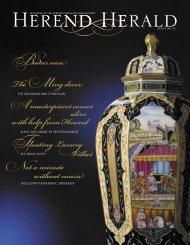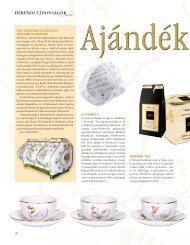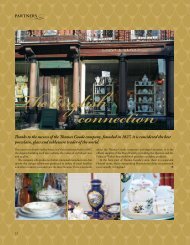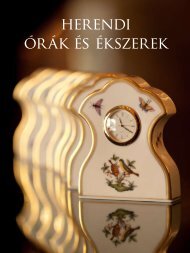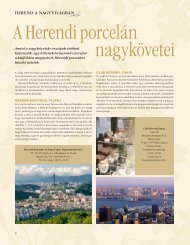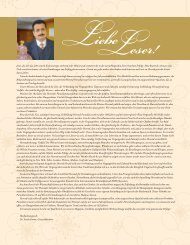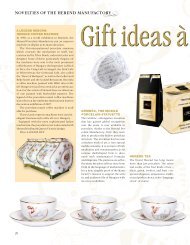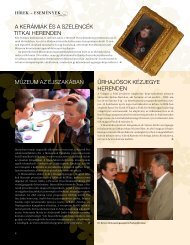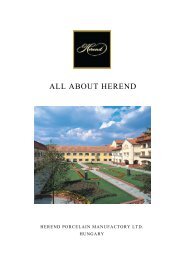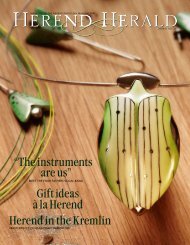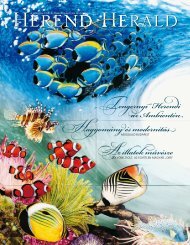LA PORCELAINE DE HEREND HEREND PORCELAIN
Genfi_32 q:Layout 1
Genfi_32 q:Layout 1
You also want an ePaper? Increase the reach of your titles
YUMPU automatically turns print PDFs into web optimized ePapers that Google loves.
Roland Blaettler<br />
Conservateur du Musée Ariana<br />
Introduction<br />
Roland Blaettler<br />
Curator of the Musée Ariana<br />
Introduction<br />
La première impulsion qui allait donner naissance au<br />
présent projet nous est venue de la présidente de la<br />
Fondation Euro-Art, laquelle a déjà soutenu activement<br />
plusieurs échanges culturels entre la Hongrie et la Suisse,<br />
notamment les grandes expositions Giacometti et Hodler<br />
présentées au Musée des Beaux Arts de Budapest,<br />
respectivement en 2003 et 2008. Lorsque Monika<br />
Rudolf-Schmidt nous approcha avec l’idée d’organiser<br />
dans nos murs une exposition consacrée à la porcelaine<br />
de Herend, nous n’avons pas tardé à entrer en matière,<br />
et pour plusieurs raisons. D’abord parce que la manufacture<br />
hongroise, bien qu’elle soit de création relativement<br />
récente, occupe une place bien à elle dans l’histoire<br />
de la porcelaine européenne. Même si elle s’est forgé son<br />
savoir-faire et sa réputation d’abord en revisitant les<br />
grands classiques du XVIII e siècle, l’âge d’or de la porcelaine<br />
européenne, se situant ainsi aux avant-postes de<br />
l‘historicisme naissant, elle réussira à imposer sa propre<br />
identité et à se positionner d’emblée sur un marché<br />
international de haut de gamme.<br />
Nous en voulons pour preuve le fait que le Musée Ariana<br />
conserve aujourd’hui cent dix porcelaines de Herend,<br />
dont seize spécimens particulièrement intéressants (par<br />
exemple le service Watteau N° 7) qui furent acquis par<br />
le fondateur du musée lui-même, Gustave Revilliod<br />
(1817-1890). S’agissant de sa collection de céramique –<br />
qui ne constituait alors qu’un aspect parmi d’autres de<br />
son musée encyclopédique – l’ambition de Revilliod était<br />
clairement de rassembler un panorama aussi complet<br />
que possible de l’histoire de la céramique européenne.<br />
Herend est pratiquement la seule manufacture «moderne»<br />
à figurer dans son catalogue. En regard de la<br />
notice correspondant à un vase de type Wales (voir<br />
N° 33-35), on y lit une appréciation particulière, comme<br />
il n’y en a que peu dans ledit catalogue: «travail remarquable».<br />
Pour un amateur comme Revilliod, Herend<br />
comptait assurément parmi les meilleures productions<br />
de l’époque, d’autant plus que le style historiciste de ces<br />
porcelaines correspondait parfaitement à sa sensibilité,<br />
comme en témoignent les partis pris esthétiques qui se<br />
manifestent dans l’architecture de l’Ariana.<br />
Dans notre exposition nous avons ménagé une large<br />
place aux porcelaines inspirées de la Chine et du Japon,<br />
parce que nous y voyons l’une des contributions les plus<br />
originales et les plus stimulantes de Herend, mais également<br />
parce que cet aspect rejoint l’une des lignes de force<br />
de nos collections et de notre exposition permanente,<br />
l’histoire sans cesse renouvelée des échanges réciproques<br />
entre les cultures céramiques d’Orient et d’Occident.<br />
Que soient remerciées ici les personnes et les institutions<br />
qui ont permis la réalisation de cette exposition. Notre<br />
collègue Gabriella Balla, conservatrice au Musée des<br />
arts décoratifs de Budapest, pour sa contribution à la<br />
présente publication, mais également pour l‘ouvrage<br />
qu’elle publia en 2003, Herend Porcelain. A Hungarian<br />
institution, une remarquable histoire de la manufacture<br />
qui nous a guidés et inspirés tout au long de la conception<br />
de ce projet.<br />
The impetus for this project initially came from the<br />
President of the Euro-Art Foundation, who had already<br />
actively supported a number of cultural exchanges<br />
between Hungary and Switzerland, especially the major<br />
Giacometti and Hodler exhibitions held in Budapest Fine<br />
Art Museum in 2003 and 2008 respectively. When<br />
Monika Rudolf-Schmidt approached us with the idea of<br />
organising an exhibition of Herend porcelain in our<br />
museum, we wasted no time in following up the idea, for<br />
several reasons. The first was that this Hungarian porcelain<br />
manufacturer, although relatively recent, has a place<br />
all of its own in the history of European porcelain. Even<br />
if it first earned its knowhow and reputation by revisiting<br />
the great classics of the 18th century, the golden age of<br />
European porcelain, and thus was an early adopter of<br />
the then nascent historicism, it successfully imposed its<br />
own identity and occupied an upmarket international<br />
position from the start.<br />
Proof of that is provided by the fact that the Ariana<br />
Museum currently holds 110 pieces of Herend china,<br />
including 16 particularly interesting specimens (the<br />
Watteau service for example - No. 7) acquired by the<br />
museum’s founder, Gustave Revilliod (1817-1890).<br />
Revilliod’s ambition for his ceramics collection – which<br />
was only one of the many facets of his encyclopaedic<br />
museum – was clearly to collect as complete a panorama<br />
as possible of the history of European ceramics. Herend<br />
is practically the only “modern” porcelain factory in his<br />
catalogue. Opposite the entry for a Wales–type vase (see<br />
Nos. 33-35), we find a particular judgement that occurs<br />
only rarely in this catalogue: “remarkable work“. To a<br />
ceramics-lover like Revilliod, Herend was definitely one<br />
of the best producers of the period, especially as the<br />
historicist style of these pieces of china was perfectly in<br />
tune with his own sensibility, as is shown by the aesthetic<br />
bias in the architecture of the Musée Ariana.<br />
In our exhibition, we have given a good deal of space to<br />
China and Japan-inspired porcelain, because we consider<br />
them to be among Herend’s most original and stimula ting<br />
contributions, but also because that aspect fits in with<br />
one of the main themes of our collections and our perma -<br />
nent exhibition: the constantly renewed story of mutual<br />
exchanges between the ceramic cultures of East and West.<br />
I wish to take this opportunity to thank the people and<br />
institutions that enabled this exhibition to be mounted.<br />
Our colleague, Gabriella Balla, Curator at the Budapest<br />
Museum of Applied Arts, for her contribution to this<br />
publication, but also for the book she published in 2003,<br />
“Herend Porcelain. A Hungarian institution” – a remar -<br />
kable history of the factory that guided and inspired us<br />
throughout the creation of this project.<br />
This exhibition would not have been as dazzling without<br />
the high-quality pieces the Museum of Applied Arts in<br />
Budapest was kind enough to entrust to us temporarily.<br />
We are profoundly grateful to its director, Mrs Zsuszanna<br />
Renner, and to Mr Zsombor Jékely, who is in charge of<br />
research and exhibitions.<br />
5



